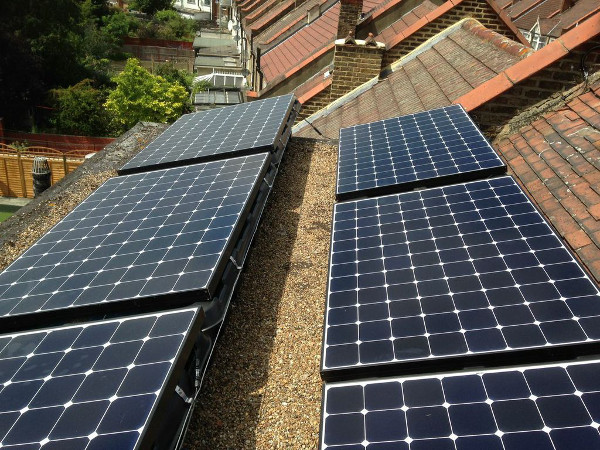
“I’d put my money on the sun and solar energy. What a source of power! I hope we don’t have to wait until oil and coal run out before we tackle that.” – Thomas Edison, 1931
What is solar electricity?
Solar electricity is the generation of electricity from the power of the sun, via photovoltaic (PV) cells. It is different from solar water heating, where water passes through panels to be heated directly, and no electricity is generated.
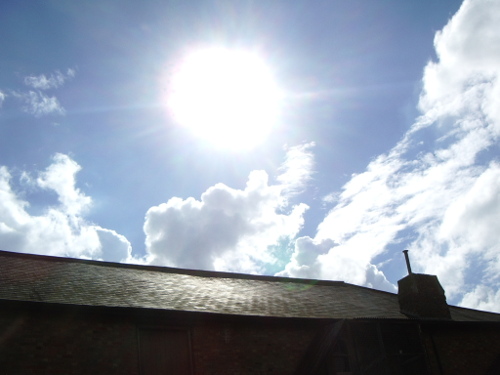
Photovoltaic cells are made from silicon; when particles of sunlight (photons) fall on the cells, they dislodge the outer electrons of the silicon atoms, and push them along to the next atom; a chain of moving electrons is produced, and if a wire is attached to the panels, these electrons can be pushed down it to supply a useable electric current. This current is measured in amps, and to give some idea of the scale involved, one amp of current involves the movement of 6 million million million electrons per second.

The solar electricity produced this way (and also from batteries) flows in one direction only, and so is called direct current, whereas electricity from the UK national grid is alternating current, as the flow of electrons changes direction 50 times per second. Direct current can be stored in batteries to power 12 volt appliances. However, these are more expensive and less readily available than ordinary domestic 240 volt appliances, so batteries and an inverter can be used to convert the 12 volt direct current to 240 volt alternating current.
Alternatively, the panels can be connected to the grid through a solar grid inverter with a meter to record how much electricity has been generated, whether it’s used in the home or exported . A grid-support system is one where batteries are also included to store surplus electricity that would have been exported into the grid. This can then be used to buffer loads taken from the grid later in the day – the loads are shared between the batteries and the grid to reduce grid consumption. Battery damage is prevented by a battery management system (BMS) to prevent both over-discharge and over-charging.
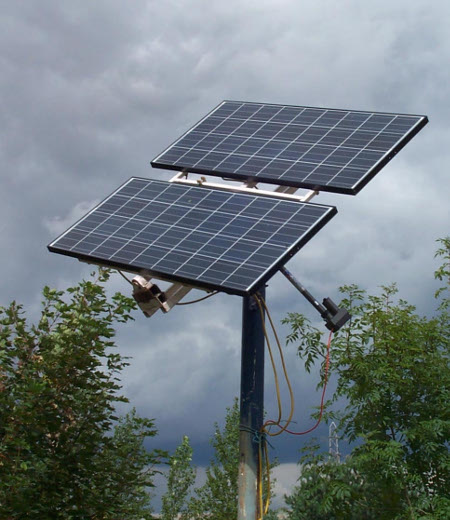
What are the benefits of solar electricity?
As a renewable source of energy, the main environmental benefits of PV are based on the fact that it doesn’t cause the problems that other types of electricity generation do.
Burning fossil fuels in conventional power stations releases nitric oxides, nitrogen dioxide and sulphur dioxide, causing acid rain which damages forests, wildlife and human health; it also releases carbon monoxide, nitrous oxides, lead, particulates and hydrocarbons, which cause damage to plants, ecosystems, and human health – especially respiratory problems. Also, burning fossil fuels releases over 35 billion tonnes of CO2 into the atmosphere each year. CO2 is the most important of the ‘greenhouse gases’ responsible for global warming. Fossil fuel generation of electricity results in ten times the carbon emissions of solar PV per unit generated.

With PV solar electricity there are no emissions in use, no environmentally-damaging extraction and transport of coal and oil to feed power stations, and no radioactive waste, or the potential leaks and disasters associated with nuclear power stations. However, there are also environmental problems caused by the extraction of materials, manufacturing and waste associated with solar PV. These problems are less serious than the impact of fossil fuel extraction and burning, or the catastrophic nuclear disasters that seem to happen every 10-20 years. The application of technology will reduce the impact of PV in ways that are not possible for fossil fuels or nuclear.
PV modules generate between 9 and 34 times the amount of electricity in their lifetime as is used in their manufacture.
Roof installation video from our solar electricity online course.
Large-scale use of lead-acid batteries cause environmental problems in their manufacture and disposal, so connection to the grid would be better environmentally, unless in a remote location. Batteries do mean that you are autonomous though, and not subject to power cuts. The use of second hand traction batteries can extend the battery life for up to another 20 years if correctly maintained and used with correctly sized system and so can improve your knowledge and skill base considerably.
Solar PV can democratise and decentralise our energy supply. Some technologies can only be controlled by the state or the corporate sector – like coal- or oil-fired or nuclear power stations. PV generation (although not the manufacture of the panels, yet) can be controlled by individuals and communities, along with other sources of energy such as wind, hydro or wood. Ivan Illich called these kinds of technologies ‘convivial‘. We don’t think that control of something as important as our energy supply should be concentrated in the state or a few giant corporations.
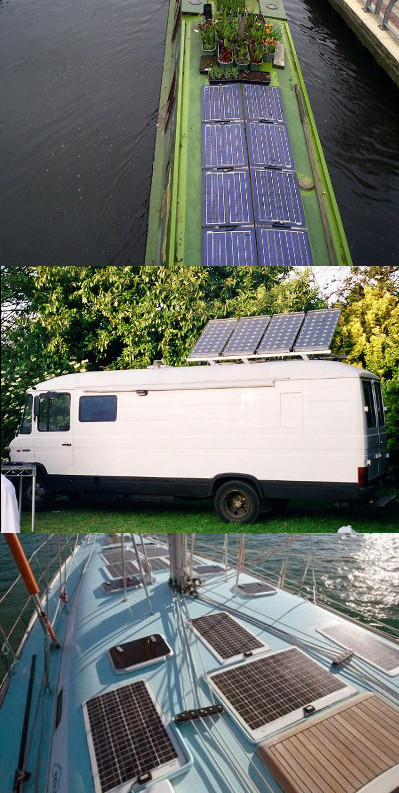
What can I do?
You may think that PV is fine for the tropics, but can they work in temperate countries? Well, the UK receives on average around 800kW of solar energy per square metre per year, which represents around a quarter of the annual requirement of a typical family. There’s enough south-facing roof space in the UK to provide all the country’s electricity needs using PV.
Solar can be put to a range of different uses – a single panel can be used with a battery to power lights or animal fencing in a remote location, or you can attempt to supply all or most of your electricity with a large system.

The first thing to do is find out how much electricity (in kilowatt-hours, kWh) you use in a year (check your bills – a kWh is a unit of electricity on your bill), and think about ways to reduce your usage: switch lights off when you leave the room; don’t leave appliances on standby; use a laptop (c. 18 watts) instead of a desktop (c. 180 watts); use Savaplugs and low-energy lighting and appliances; don’t overfill kettles; think about solar hot water and a wood-burning stove, and whether you need so much electrical gear at all.
A typical UK family will use about 3000-4000kWh per year, but if you’re single with no children and / or reduce your electricity consumption, that figure might be 2000kWh per year. Taking the annual amount of sunshine into consideration, this will require a 2.4kW system. But any size system will help save money and carbon emissions.

There are currently no financial incentives for new installations, but with huge reductions in the cost of parts over the last 10 years, it’s eminently sensible to fit your own system. As you extend your grid solar system there will be a point where you’re exporting more than half of your power. As rules continue to change about whether and how much you get paid for the power you export to the grid, this could be the time to fit a diverter that monitors any potential export and instead of letting this happen, diverts the power that would have been exported into a dedicated load, like your immersion heater, storage heater, or electric vehicle; see video:
Installing a grid diverter to prevent export to the grid.
One of our course tutors (in the days before feed-in tariffs) installed panels and an inverter costing £3000, metered the electricity they produced, and compared the results to putting £3000 in the bank and paying his electricity bills from that. After 18 years the money in the bank was gone, but his PV system had paid for itself 6 years previously, and was still generating electricity. So payback times can be very project-specific, and can often be cost-effective even without government incentives.
The cost can’t (easily) be reduced by self-build (like solar hot water), because the manufacturing process is too high-tech, but you could self-install if you have the know-how. Of course you could use PV in combination with a wind turbine to take advantage of all weather conditions.
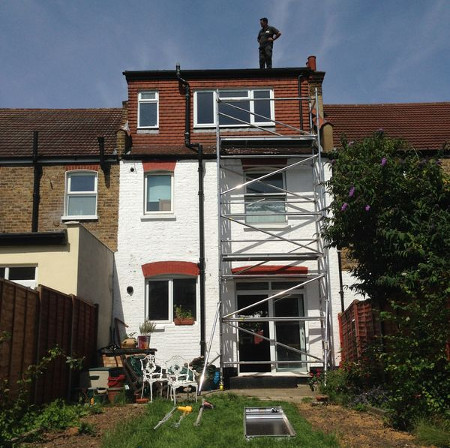
Other factors to consider with solar electricity are: is your roof south-facing? Is it big enough? (if not, panels could be located on a frame in the garden or on a flat roof) Is it shaded? (If just one of your panels is partially shaded, it can affect all the panels in your system). If you’re using batteries they need to be deep-cycle (able to be continuously drained and re-charged) with a charge controller to prevent overcharging.
See our further info section for everything you need to think about if you’re considering a solar PV installation, and if you want to have a go at installing a system yourself, have a look at our book, Wind & Solar Electricity, and/or our online course.
Whilst you’re here, why not take a look at the other 25+ utilities topics available? And don’t forget to visit our main topics page to explore over 200 aspects of low-impact living and our homepage to learn more about why we do what we do.
The specialist(s) below will respond to queries on this topic. Please comment in the box at the bottom of the page.
 Andy Reynolds is a carpenter / joiner and woodsman who has tutored courses and authored books with us. He has lived on a smallholding in Lincolnshire since the early 80s, renovated a house, built a holiday cottage and got off-grid. He records his adventures with educational videos on his YouTube channel.
Andy Reynolds is a carpenter / joiner and woodsman who has tutored courses and authored books with us. He has lived on a smallholding in Lincolnshire since the early 80s, renovated a house, built a holiday cottage and got off-grid. He records his adventures with educational videos on his YouTube channel.
The views expressed here are those of the author and not necessarily lowimpact.org's
23 Comments
-
1walapini June 11th, 2016
Hi there, I would appreciate any advice on reputable solar off grid system suppliers.
I currently have a quote for this system 3.1kwh 24V EasySolar Small Off-Grid AC Kit from Windandsun, see below.
http://www.windandsun.co.uk/products/Kits/Off-Grid-Kits#11780
I look forward to any advice !
Paul
(France)
-
2Andy June 12th, 2016
Hi. You are asking a difficult question as I do not know your skill level and what you want to power. However I have looked at the link and can comment that: 6 x 250w panels is not 3.1Kw of generation, but 1.5 Kw. I do not like maitenace free sealed batteries as they are less forgiving to misuse. Traction flooded batteries are better. Pulse width modulation charge control is helpful but with divert controlling the power can be use for other things. If you want to learn a huge amount check out Wind and Solar Electricity (edition three) and my youtube channel. Cheers
-
3walapini June 13th, 2016
Hi Andy thanks for your reply.
My skill level is novice which is why I opted for a off grid kit.
I think this off grid kit is perhaps a good starting point compared to the previous link http://www.bimblesolar.com/offgrid/48vsolar/3.5kw-shanghi-complete
-
4Andy June 14th, 2016
Hi. 48v is so much better than 24v as there is less parallel batteries and the current per Kw is lower. 20 x 175 watt panels @ a nominal 12v, but with MPPT charge controller this will help boost the output. Remember with MPPT control the string voltage needs to be much higher than the battery voltage to make the MPPT work.
A minor investment in the book would return dramatic rewards in understanding.
Here’s a few links:
One of the videos on my channel: https://www.youtube.com/watch?v=XlP9tXZ1xSQ
Book: http://lowimpactorg.wpengine.com/wind-solar-electricity-3rd-edition/
Good luck
-
5walapini June 20th, 2016
Ive found a company in Belgium that offer kits for a cheaper price:
http://www.wattuneed.com/en/230v-off-grid-solar-kit/1489-hybrid-kit-5000w.html
-
6Harshida Dave April 11th, 2017
Call for specialist help with Solar Voltaic Panel installation and review of efficiency of existing array at the Sambhavana Clinic in Bhopal, India.
Do you or your organisation have experience of Solar PV that you are able to share with the Sambhavana clinic and Oriya Busti in Bhopal, India?
We would very much like to hear from you and discuss the potential of undertaking this critical development to reach our goal of free and sustainable healthcare for survivors of Union Carbide’s factory explosion and chemical carnage.
Please contact the UK office of the Bhopal Medical Appeal in Brighton in the first instance on 01273 603 278 or [email protected] quoting Solar PV project by 15th May and I will call to discuss our human potential to make this possible.
Thank you:
Hashida
-
7Beth Denman May 5th, 2017
Hiya, I’m hoping that you may be able to help us. We are near Carmarthen in Wales and are off grid. The guy who helped us with our solar power doesn’t seem to know as much as he thought. We have 4 panels an inverter and a charge control box. No isolators, fuses or any way to turn of the power. Do you know of anyone down this way who could tell us what we need to add to make the system safe and who would come and install it properly.
we bought your book, but I’m afraid we were not able to understand what changes we needed to make.
Thanks,
Regards Beth
-
8dave May 5th, 2017
I read up on the issues for my solar 12v 22Ah leisure battery charger on my Citroen Berlingo. On my little system a 15A fuse is fixed between the 12v power socket+ and battery+. This is just for LED lights and laptops for a few hours evening camping.
What made you notice the problem ? Did something catch fire, melt or explode ?
Are realising that you want fuses/circuit breakers in case of dud appliances or children poking the 230v AC sockets ?
If you have 13A switched sockets coming from your inverter, the easiest and most useful safety feature is ordinary 230V 5A and 10A Mains circuit breakers which are effectively fuses that behave like an automatic switch that clicks OFF if the current goes too high, like a short circuit or faulty appliance would cause. …
Do you want to move the solar panels and/or disconnect the wiring ? If you have to disconnect the 12v wires always wrap the bare wires in insulating tape so they don’t short out. Then you are safe to disconnect the 230V inverter output and do the same there.
I live near Portsmouth, Hampshire, but hoping to visit Pembrokeshire in a few months time.
-
9Andy May 5th, 2017
Hi, Beth, there are loads of issues that could be a problem including the issue of self reliance. Are the panels on a grid inverter or are they part of a battery system? Isolators are not difficult to fit, they are just switches in the DC cable. The book should give you plenty of guidence and I am running a solar course for Brighton Permaculture in July. I would be interested if you wnat to send me further details of your system. Cheers, Andy
-
10Mike June 1st, 2018
I enjoyed your video from youtube about the Mastervolt Soladin 600 and a reduction in electricity bills. I’ve added a single panel and used a micro inverter from enphase and it’s working well. Each day the sun come up and the electricity meter runs slowly, not sure what the power company will make of our next readings but it’s all fun proving it works. Somehow my generated watts are never more than those in use in the house and i worry that somehow my meter prevents exporting and is holding back the inverter’s output. Is this possible? Even during the day with the house running in stand by mode were never exporting even a single watt but wierdly ramping the used power up for no reason I can see.
-
11Andy June 1st, 2018
Hi, reply to Mike, most UK electricity meters will not work backwards, except the early ones. This means that you cannot quantify the power that you are exporting, hence there is no clue to what is happening when generation exceeds consumption beyond the meter stopping. I single panel is great as it makes a contribution to background comsumption. We have many more panels and our diverter prevents most of the export. There are several videos about this and a lowimpact blog (May 2016) Cheers, Andy
-
12dave swords November 14th, 2018
Hi andy
I met u at a solar pv day course in brighton and bought ur book! Great book by the way
im looking at an off grid system and wondered if u do any consultacy work to advise me on what to buy and best design practise?
Cheers
dave swords
[email protected]
-
13Andy November 15th, 2018
Dave Swords, That all depends on where you are and what system you require. Edition 3 of the book should give you most of the info, victron inverters, steca charge controllers,forklift batteries and remember there’s no such thing as too many panels, cheers, Andy
-
14dave swords November 15th, 2018
Thanks andy ur a star.im in liphook near guildford
am I right in thinking that if I have 2 banks of solar panels, one on roof and a ground bank of panels say 50ft away that I need a charge controller for each seperate bank of sokar panels?
does the 50ft distance dictate a preferred system voltage?
many thanks
dave
-
15Andy November 16th, 2018
Dave Swords, yes you will need a separate charge controller for each array. The choice of system voltage is covered on page 158. 48v is great for a large system but charge controller for 24v are cheaper and easier to find, some of the cheap ones are dual 12 / 24v. The cable for a 24v system will have to be bigger cross section, depends on how big you want the system to eventually grow to. Cheers, Andy
-
16davesw April 23rd, 2019
hi dudes
i have been wondering how to connect solar PV panels directly to a hot water cylinder immersion heater in an off grid situation. Do you have to match the pv panel resistance to the resistance of the immersion heater?. what type of immersion do i need, a 240v ac immersion probably isnt suitable i guess. apologies for the rambling questions im not sure if its easily doable
many thanks dave
-
17Andy April 24th, 2019
Davesw, not sure where you are in the world but let’s work on an assumption of mains power at 240v, so if you want to run an immersion heater direct from solar then the panel voltage needs to be someting like mains voltage. A standard 250w panell runs between 26 and 30v depending on the load. So 6 panels in series will give something like 170v. Now for the current, in full good direct sun the panels may give out 8 amps, but let’s work on an average of 6 amps, so 6 ampsx 170v = 1000w (1 Kw). Add another panel to the series would give 195v and 1200 watts. Hope that makes sense. You may be missing some benefits here, although I can see the simplicity. If you add the rest of an off grid system, namely inverter, batteries, charge controller then you will have power for the rest of your equipment. 2 extra things here, 1/ there is no such thing as too many solar panels, 2/ you can down-rate an immersion heater by using a transformer in circuit. If you half the voltage then you half the current as a general rule of thumb. So for a 240v 3Kw immersion heater that would normally draw 13 amps, if you half the voltage to 110 (with a transfoirmer) then 110v x 6.5 amps = 700 watts.
I think you need to buy and read the lowimpact book “Wind and Solar Electricity” . Scroll down on the home page to find “our publications”. Hope this helps, cheers
-
18Andy April 24th, 2019
davesw, just a quick extra note, the transformer method of de-tuning an immersion heater can only be used with AC, so in your case this would be from an inverter. Transformers don’t work with DC, cheers
-
19dave swords June 24th, 2019
Hi andy
is there any value in changing the pv panels wiring configuration summer to winter where the pv panel output drops significantly? Read this somewhere and didnt chase it down
thanks dave
-
20Andy June 25th, 2019
Dave Swords, I wouldn’t mess about with this as a grid inverter has a variable buck converter to deal with variable voltage and current from the panels. It’s also problematic to over-drive grid inverters as it leads to early failure, search yputube for “Solar grid inverters, prevent failure, extending working life”. For a battery system the panels need to be suitable for the system voltage unless you install an MPPT charge controller that will take a higher voltage input and convert this high voltage into watts. The next Solar course in Brighton is June 13th 2010 for BPT. Cheers, Andy
-
21Martin January 10th, 2021
Andy. I read your book on solar and wind power and probably going to sign up for the course, very interesting! A question if I may about batteries. The book, published in 2016, focuses on deep-cycle, lead-acid traction batteries for storage. Has that view changed in the last four years as automotive lithium ion are being used for storage? Just a bit concerned about acid in the playground!
Broadly, I am looking at putting up a 5m x 7m log cabin at a school to be used as a intervention / group room and, having mentioned it to the Head, would like to have it power itself through solar (possibly wind also) power. The major challenge would be heating, especially in winter months, and I am going to investigate air sourced heat pumps as a solution. Lighting could be via 12v MR11 LED bulbs, 4w to 5w each not sure how many yet, possibly 10. A 240v supply to run a vacuum cleaner in the afternoons and charge one or two laptops. At the moment I am guessing the south facing roof will accommodate 6 to 9 panels.
When I have re-read your book and followed the course I will have a better idea of whether this is feasible. I have a 9-panel grid-connected system which has been running perfectly since April 2014. Thinking about ways I can expand that as our installer is not interested!
-
22Andy January 11th, 2021
Martin, batteries have moved on dramatically since edition 3 was published, but the book focused on lead acid traction as a relatively cheap way of storing power. With the advent of lithium polymer units that will cope with many cycles things are different but so are the batteries, they battery management systems (BMS) and these are commonly (but not always) built into the units. The problem is cost and so this highlights the calculations on battery capacity. If you have a mains connection to this building then there are 2 options, stand alone system with a UPS inverter from a 24 or 48v battery, or grid inverter with a power wall type lithium battery that works on power sharing and battery management. The latter smooths things out for techno-phobes who’s awareness of energy consumption is marginal. Heating is difficult and as we have just suffered low light levels for the last 2 months we have been using back-up power on a regular basis. The Earth ship in Brighton has passive solar and heat storage walls this seems to work well in conjunction with major insulation. With solar it is all about surface area and we run 60 large panels and still have generation problems especially November and December. Hope this helps, cheers, Andy
-
23Martin January 12th, 2021
Andy, thank you for your time in replying, greatly appreciated. Haven’t got the building yet, just a quote to supply and ready muscles to put it up – two old men with a log cabin! Haven’t got the money either, crowdfunding will be the solution but I need to have a good estimate of how much we need to raise first. I take onboard all that you have said and resign myself to having to suggest digging up across the playground to get a mains cable through. Mind you, the children are only there between 08:30 and 15:00 (COVID restrictions allowing), it’s daylight and they should eat more carrots! There will be a way to promote and utilise renewables, I need to work on it a bit more. I like the sound of heat storage walls, a visit to the Earth Ship (online) is in order. Thanks again.





 Batteries
Batteries
 Community energy
Community energy
 Green electricity
Green electricity
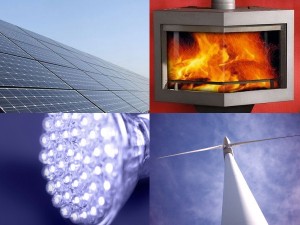 Low-impact energy
Low-impact energy
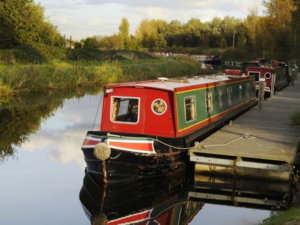 Narrowboats
Narrowboats
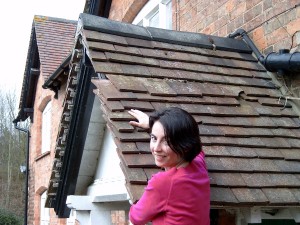 Roofing
Roofing
 Sail boats
Sail boats
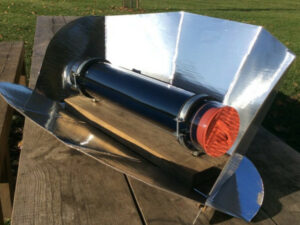 Solar cookers
Solar cookers
 Solar hot water
Solar hot water
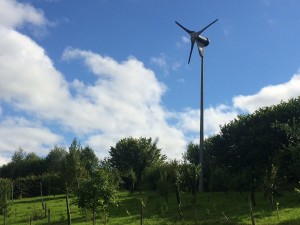 Wind generators
Wind generators


